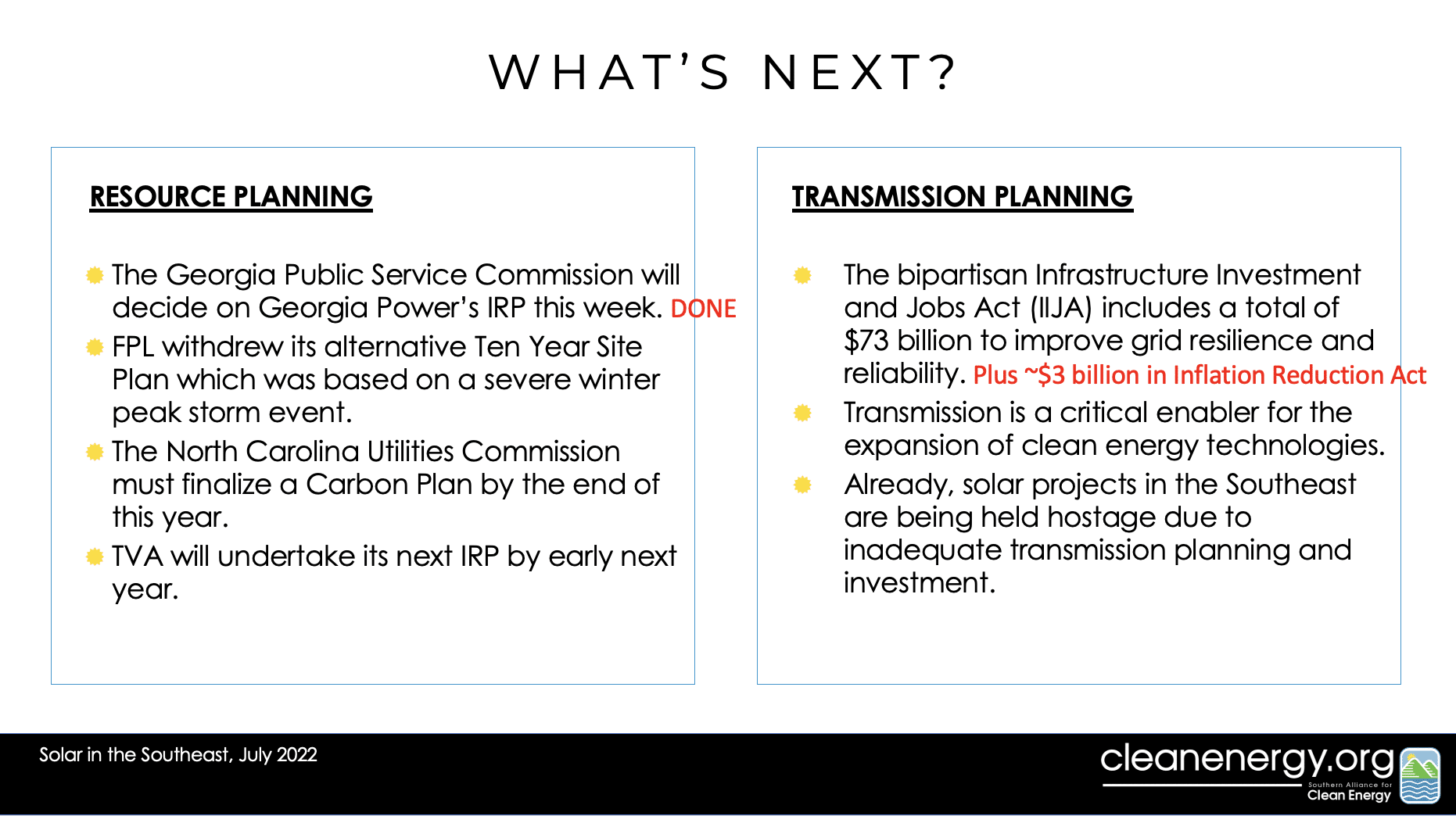For the final blog post in this series associated with our "Solar in the Southeast" annual report, SACE offers predictions about "What's Next?"
Bryan Jacob | August 25, 2022 | Solar, Utilities Download the Report Read the Blog Series Watch the report webinar
Download the Report Read the Blog Series Watch the report webinar
In the webinar for the “Solar in the Southeast” annual report, we incorporated a discussion of “What’s Next?” focused on both Resource Planning and Transmission Planning. Below is the slide we used – along with a couple of updates.

Resource Planning
In the webinar, we described several major resource planning efforts that were either underway or on the immediate horizon.
Georgia Power
When we released the report in July, a triennial Integrated Resource Plan (IRP) or long-term resource plan was wrapping up in Georgia. That process has now concluded. One result of the IRP process, Georgia Power will be adding 2.3 GW of solar between 2026 and 2029. The utility will also be initiating a competitive bid process for 500 MW of energy storage. That 500 MW project is in addition to a 265 MW project it was authorized to develop on its own.
Florida Power & Light
Just days before the webinar, Florida Power & Light (FPL) had withdrawn its alternative resource plan and reverted back to the ordinary Ten Year Site Plan (TYSP) – which SACE had adopted for our forecast. Planning for winter reliability does, however, remain critical and will play an increasing role in resource planning processes.
Duke Energy
In North Carolina, House Bill 951 (2021) requires the North Carolina Utilities Commission (NCUC) to adopt a “Carbon Plan” by the end of 2022. Duke Energy filed its proposed plan(s) in May. SACE and other intervenors have since recommended an alternate plan. The NCUC held public hearings at various locations around the state to solicit public comments and will now hold hearings in September for expert witness testimony. All of this will inform the Commission’s plan which must reduce utility emissions 70% by 2030 (compared to 2005) and they must reach net zero by 2050.
Tennessee Valley Authority
Tennessee Valley Authority (TVA) also has an IRP on the horizon. TVA is presently operating under its 2019 IRP, which was neither sufficiently transparent nor inclusive and failed to deliver on energy efficiency and renewable energy. TVA, which is a federal monopoly utility, typically updates its IRP every five years, though it can opt to do so sooner. And since the process takes around two years, we anticipate TVA will begin later this year or in early 2023. TVA has recently issued a Request for Proposal for “carbon free” electric capacity (up to 5 GW). That is an encouraging sign and should provide marketplace data as inputs for the IRP modeling.
Other utilities in the Southeast are undertaking resource planning efforts, as well, but these are the largest and will have an outsized impact on the solar forecast for next year’s annual report.
Transmission Planning
We also predict that transmission planning will play an important role. It is widely accepted that expanded transmission is a critical enabler for our transition to a clean energy future. Studies suggest that “a high-renewables scenario will require a two to fivefold increase in the capacity of the transmission system.“ The Bipartisan Infrastructure Law (Infrastructure Investment and Jobs Act) had already authorized $73 billion to improve grid resilience and reliability; and now that the Inflation Reduction Act has also become law, there’s an additional $2.9 billion ranging from direct loans to support for expedited siting considerations.
And there’s a potential synergy between transmission planning and resource planning. In the Southeast (as well as other parts of the country), solar projects are being delayed or rejected because of historic underinvestment in the transmission system. This is an important moment for transmission investments as an enabler for the clean energy transition.
Moving Forward
SACE will continue to engage on these topics and will be a leading voice of the Clean Energy Generation in the Southeast as our region helps forge the path to meet the challenge of unprecedented climate change head-on.
#SSR2022